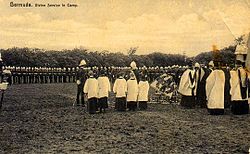Bermuda Garrison
| Bermuda Garrison | |
|---|---|
| Bermuda | |

Presentation of colours at Prospect Camp
|
|
|
Location in Bermuda
|
|
| Coordinates | 32°17′58″N 64°45′55″W / 32.2994949°N 64.7653454°WCoordinates: 32°17′58″N 64°45′55″W / 32.2994949°N 64.7653454°W |
| Type | Barracks |
| Site information | |
| Owner | Ministry of Defence |
| Operator |
|
| Site history | |
| Built | 1793 |
| Built for | War Office |
| In use | 1793 - 1957 |
The Bermuda Garrison was the military establishment maintained on the British Overseas Territory of Bermuda by the regular British Army, and its local militia and voluntary reserves from 1701 to 1957. The Garrison existed primarily to defend the Royal Naval Dockyard (HM Dockyard Bermuda) and other facilities in Bermuda that were important to Imperial security until the HM Dockyard was reduced to a base (a process that was carried out between 1951 and 1957).
Although the last professional soldiers (a detachment of the Duke of Cornwall's Light Infantry) were withdrawn in 1957, and the Garrison ceased to exist, two part-time components - the Bermuda Militia Artillery and the Bermuda Volunteer Rifle Corps (retitled Bermuda Rifles) - continued to exist until 1965, when they amalgamated to create the current Bermuda Regiment.
The English colony of Bermuda was settled accidentally in 1609 by the Virginia Company, when its flagship, the Sea Venture was wrecked off the archipelago. Although most of the settlers eventually completed their journey to Jamestown, Virginia, the company remained in possession of Bermuda, with Virginia's borders officially extended far enough out to sea to include Bermuda in 1612. In the same year, a Governor and more settlers arrived to join the three men left behind from the Sea Venture. From then until 1701, Bermuda's defence was left entirely in the hands of her own militias.
Bermuda's militia included a standing body of artillery men to garrison the forts built by the local government. The earliest of these forts built were the first stone fortifications (and buildings) in the English New World, the first coastal artillery, and are today the oldest English New World fortifications still standing. Together with St. George's town, the forts near the town (including the Castle Islands Fortifications) are today a UNESCO World Heritage Site.
...
Wikipedia

